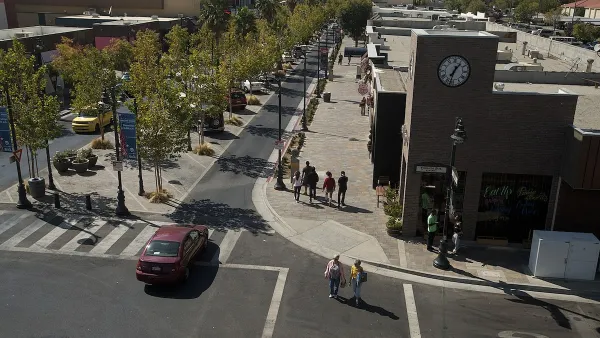A recent study strengthens the economic case for walkable communities, finding a strong inverse relationship between walkscore and risk of mortgage default.

A recent study from University of Arizona professor Gary Pivo and strengthens the economic case for walkable communities. Pivo looked at the relationship between mortgage default and walk scores for multifamily housing. He found a strong inverse relationship: low walk scores were associated with high risk of mortgage default, and high walk scores were associated with low risk of mortgage default. The relationship was strongest at the extremes:
“Where walk score was 80 or more (out of 100), the relative risk of default is 60 percent lower than where walk score is less than 80. Where walk score is 8 or less, default risk is 121 percent higher.”
These findings turn common beliefs upside down, showing that the most walkable developments are not, in fact, risky propositions. In general, in the past, it has been more difficult to finance projects in walkable areas. There are many reasons for this, but it boils down to a perception of risk on the part of lenders.
For example, the mixed-use nature of the walkable neighborhoods—with both commercial and residential space in close proximity, sometimes housed in a single building—is considered more complex for developers, financiers and investors. This complexity leads to the perception of risk, although Pivo notes, it is “unclear exactly what it is about the projects that are cause for concern.”
Furthermore, demand for housing in walkable areas appears to be on the rise. Pivo cites a study from the Urban Land Institute which found that “demand and interest in apartments in ‘American infill’ locations remain hot.” Community preference surveys from the National Association of Realtors indicate increased demand for mixed use neighborhoods, transportation choices, and short commutes. The Sonoran Institute's RESET study looked at six communities in the Rocky Mountain West, and found in most cases that people are willing to pay a premium for housing in compact, walkable neighborhoods.
So, research indicates that walkable housing is a lower-risk investment—there is consumer demand, and low likelihood of mortgage default. Walkability has also been shown to have multiple other advantages, like improved public health, reduced carbon footprint, and less pollution.
To promote walkable development, Pivo recommends that lenders offer better terms for mortgages on walkable properties. Developers consistently cite difficulty in securing financing as one of the biggest barriers to the success of mixed use and other walkable developments. It’s time to remove that barrier, and recognize the investment opportunity that awaits in these great neighborhoods.
FULL STORY: Community Builders Blog

Planetizen Federal Action Tracker
A weekly monitor of how Trump’s orders and actions are impacting planners and planning in America.

Chicago’s Ghost Rails
Just beneath the surface of the modern city lie the remnants of its expansive early 20th-century streetcar system.

San Antonio and Austin are Fusing Into one Massive Megaregion
The region spanning the two central Texas cities is growing fast, posing challenges for local infrastructure and water supplies.

Since Zion's Shuttles Went Electric “The Smog is Gone”
Visitors to Zion National Park can enjoy the canyon via the nation’s first fully electric park shuttle system.

Trump Distributing DOT Safety Funds at 1/10 Rate of Biden
Funds for Safe Streets and other transportation safety and equity programs are being held up by administrative reviews and conflicts with the Trump administration’s priorities.

German Cities Subsidize Taxis for Women Amid Wave of Violence
Free or low-cost taxi rides can help women navigate cities more safely, but critics say the programs don't address the root causes of violence against women.
Urban Design for Planners 1: Software Tools
This six-course series explores essential urban design concepts using open source software and equips planners with the tools they need to participate fully in the urban design process.
Planning for Universal Design
Learn the tools for implementing Universal Design in planning regulations.
planning NEXT
Appalachian Highlands Housing Partners
Mpact (founded as Rail~Volution)
City of Camden Redevelopment Agency
City of Astoria
City of Portland
City of Laramie





























